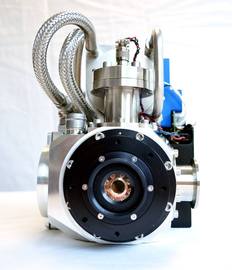 |
Date Announced: 25 Oct 2017
Meyreuil, October 18, 2017: MIRC-X, the 6-telescope beam combination instrument developed by the University of Exeter (UK) and the University of Michigan (USA), together with C-RED One, the world's fastest low noise infrared camera from First Light Imaging, are opening new perspectives in Infrared Interferometry for Astronomy.
The MIRC-X imager is now looking at the sky on the CHARA telescope array, which is the world's highest-resolution imaging facility in infrared light, located at the Mount Wilson Observatory in California. The new instrument combines the light from telescopes spaced up to 330 meters apart. These characteristics make the CHARA array and the MIRC-X instrument ideally suited for imaging stellar surface structures or to image the environment around stars with unprecedented resolution.
The MIRC-X project is led by Prof. Stefan Kraus (University of Exeter, UK) and Prof. John Monnier (University of Michigan, USA) and funded by the European Research Council[1] and building on earlier funding from the USA's National Science Foundation. The ambitious goal is to image the discs around young stars for the first time with 6-telescopes infrared interferometry. These discs constitute the left-over material from the star formation process and provide the stage where planets form. Once planets have formed, they shape the disc environment, for instance by carving out gaps or by stirring up the disc material in warps. Spotting these structures in the inner disc regions requires an angular resolution far beyond the reach of conventional telescopes. MIRC-X and CHARA overcome this resolution barrier by combining the light from physically separated telescopes, achieving the image sharpness of a 330m telescope. These new capabilities will enable astronomers to obtain high-fidelity images of protoplanetary disc, providing a glimpse on how our own solar system might have looked like 4.6 billion years ago, during its formation phase.
C-RED One is a scientific commercial camera developed by First Light Imaging, dedicated to short-wave infrared (SWIR) imaging. It is based on the SAPHIRA e-APD detector from LEONARDO, allowing avalanche amplification and multiplication of electrons. C-RED One's innovative mechanics and electronics offers unprecedented speed and sensitivity records: 3500 frames per second, with a read-out noise lower than 1 electron.
So far, the sensitivity of infrared interferometric instruments has been limited primarily by the read-noise of the detectors that are used for recording the faint interference pattern formed by the starlight. The C-RED One's e-APD technology reduces these read-noise contributions by several orders of magnitudes, enabling MIRC-X to detect the faint interference pattern associated with protoplanetary discs.
C-RED One is the only commercially-available infrared camera based on the e-APD Technology. The three-year development of the C-RED One has been funded by the European Commission in the frame of the Horizon 2020[2] SME Instrument program. In 2016, C-RED One was rewarded with a Prism Award for Photonics Innovation by SPIE / PhotonicsMedia.
For more information about C-RED One: www.first-light.fr/c-red-one-project/
For more information about MIRC-X: http://mircx.skraus.eu
Start-up created in 2011, emanating from public research laboratories[3], First Light Imaging designs and manufactures high-technology scientific cameras for both visible and infrared spectra. The company has already been funded twice by the Ministry of Higher Education and Research and the Public Investment Bank (BPI) in France.
OCAM², C-RED One and C-RED 2 are the world's fastest and most sensitive cameras for visible or infrared wavelengths. They already chosen by the world's biggest telescopes and institutes, such as the Subaru Telescope in Hawaii or GranTeCan in Spain.
First Light Imaging also brings its expertise to the NASA space agency.
[1] MIRC-X is funded in parts through the European Research Council (ERC) as part of grant agreement No 639889.
[2] C-RED One: The project leading to this application has received funding from the European Union's Horizon 2020 research and innovation programme under grant agreement No 673944.
[3] Marseille Astrophysics Laboratory (CNRS-INSU and Aix-Marseille University), IPAG (Grenoble Institute of Planetology and Astrophysics), OHP (Haute –Provence Observatory, CNRS)
| First Light Imaging |
| Europarc sainte victoire, Bat 6 |
| Route de Valbrillant, le Canet |
| Meyreuil |
| 13590 |
| France |
| Tel: 0442612920 |
E-mail: cecile.brun@first-light.fr
Web Site: https://www.first-light.fr/
| © 2025 SPIE Europe |
|